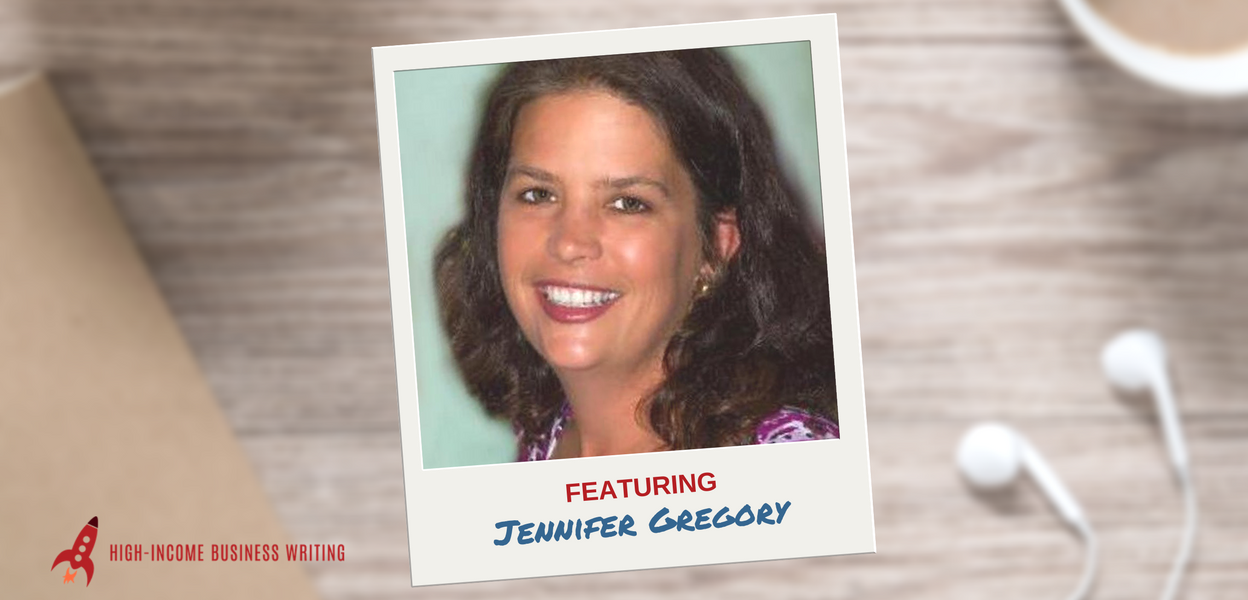North Carolina–based freelance writer Jennifer Gregory has had quite a ride over the past 18 months.
She took her business to the six-figure level in 2015. But then shortly after, she lost some of her anchor clients. And things started to fall apart.
Jennifer didn’t sit around for very long. She quickly went back to the drawing board, drafted a turnaround plan and took massive action.
Within weeks she was booked solid. And 2016 is shaping up to be a banner year for her.
In this interview, Jennifer details her wild journey to the $100,000 income level. She reveals the 6 things she did that enabled her to get there. And she walks us through the plan she executed to replace her lost anchor clients.
Regardless of where you are in your freelance business, I think you’ll find some great ideas and inspiration in Jennifer’s story.
The notes that follow are a very basic, unedited summary of the show. There’s a lot more detail in the audio version. You can listen to the show using the audio player below. Or you can subscribe in iTunes to get this show delivered straight to the Podcasts app on your smart phone, tablet or iPod.


High-Income Business Writing with Ed Gandia
#103: How Freelance Writer Jennifer Gregory Took Her Income to $100,000 in 6 Simple Steps
Tell us about yourself
Jennifer Gregory lives in Raleigh, North Carolina. She got her start in technical writing. About eight years ago, she started a freelance writing business when her kids entered school.
Today, she specializes in content marketing writing. Her clients have included some big names, such as IBM, Adobe, MS, Samsung, State Farm and All State.
In 2015, your income surpassed six-figures. How did you do it?
1. She took on fewer clients
Jennifer’s income went down in 2014, partly because she had a lot of small and medium size clients. She realized these clients took up a disproportionate amount of her time because she had to get up to speed with each of them.
With bigger, longer-term clients, she could spend less time marketing, getting up to speed and waiting for new projects to come in.
In 2015, she started having 30-minute phone calls with every potential client before agreeing to work with them. It helps her make sure clients are a good fit, so they’re more likely to stay clients long term.
2. She narrowed her niche
Previously, Jennifer had identified her niche as personal finance and technology. But in 2015, she went further and targeted data analytics.
Data analytics is a hot topic with few qualified writers, so she could command a higher fee.
3. She learned how to negotiate better
Jennifer says she’s a terrible negotiator—especially on the phone. In 2015, she shifted negotiations from phone to email.
Negotiating by email gives her time to consider her responses and makes her bolder.
4. She started treating her business as a business
When people asked her what she does for a living, she used to say, “I’m a writer.”
Now, she says, “I own my own freelance writing business.”
This mindset shift from writer to business owner gave her the determination to invest in her business. As a result, she revamped her website, attended Content Marketing World and started outsourcing more work.
5. She decided to work only with nice people
Working with jerks is stressful. And when we’re stressed, we don’t do our best work.
Jennifer started turning down clients she didn’t really like. As a result, she spends less time procrastinating. She enjoys her work more and her productivity is up.
6. She made time for “fulfilling” writing
While Jennifer likes writing about data analytics, it’s not always fulfilling. Most of us got into writing because it’s part of who we are. When it’s also your job, it’s easy to forget to feed the writer within.
In 2015, Jennifer took the time to write some essays for a parenting magazine. It didn’t pay much, but it was a lot of fun. She also enjoys writing for her blog.
When we feel good, we’re more productive. So make time for writing that makes you feel good.
In early 2016, you had some big setbacks. Can you tell us about that?
Jennifer ended 2015 with three big anchor clients in the bag. But when she returned to work in January, she discovered the projects had been delayed or substantially reduced.
So she made a list of marketing activities and challenged herself to implement them.
After 45 days of marketing, she ended up with about $64,000 in contracts for the year as well as a number of warm prospects.
Some of the marketing activities she undertook:
- Sent out 53 letters of introduction to content marketing agencies
- Sent out five letters of introduction to trade publications
- Followed up on 15 letters of introduction from 2015
- Created an active Twitter presence
- Targeted agencies and content marketing managers on Twitter
- Replied to 15 online job ads
- Updated her LinkedIn profile with new niches
- Updated her website with new clips
- Sent an email to three writers in her niche to see if they had any leads
- Attended a local marketing conference
- Checked in with five previous clients
- Checked in with a new client whose project was delayed.
Which activities were most successful?
Most of her success came from checking in with previous clients. She ended up getting $36,000 in business from one of them.
When following up with past clients, point out new skills or experience that could benefit them.
What did you learn from this experience?
There’s plenty of work out there. If you’re not finding it, you need to reassess what you’re doing.
This is a great time to be a writer. With the growth of content marketing, every business is a potential client.
Where can listeners learn more about you?
Jennifer’s website: The Content Marketing Writer
Jennifer’s blog: The Content Marketing Writer Blog






